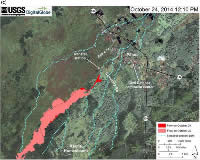Conclusion: recommendations and findings of the RED SEED working group
HARRIS A.J.L., S. CARN, J. DEHN, C. DEL NEGRO, M. T. GUÐMUNDSSON, B. CORDONNIER, T. BARNIE, E. CHAHI, S. CALVARI, T. CATRY, T. DE GROEVE, D. COPPOLA0, A. DAVIES, M. FAVALLI, F. FERRUCCI, E. FUJITA, G. GANCI, F. GAREL, P. HUET, J. KAUAHIKAUA, K. KELFOUN, V. LOMBARDO, G. MACEDONIO, J. PACHECO, M. PATRICK, N. PERGOLA, M. RAMSEY, R. RONGO, F. SAHY, K. SMITH, S. TARQUINI, T. THORDARSON, N. VILLENEUVE, P. WEBLEY, R. WRIGHT & K. ZAKSˇEK (2016).
Conclusion: recommendations and findings of the RED SEED working group, Geological Society, London, Special Publications, 426:567-648, doi:10.1144/SP426.11
Abstract
RED SEED stands for Risk Evaluation, Detection and Simulation during Effusive Eruption Disasters, and combines stakeholders from the remote sensing, modelling and response communities with experience in tracking volcanic effusive events. The group first met during a three day-long workshop held in Clermont Ferrand (France) between 28 and 30 May 2013. During each day, presentations were given reviewing the state of the art in terms of (a) volcano hot spot detection and parameterization, (b) operational satellite-based hot spot detection systems, (c) lava flow modelling and (d) response protocols during effusive crises. At the end of each presentation set, the four groups retreated to discuss and report on requirements for a truly integrated and operational response that satisfactorily combines remote sensors, modellers and responders during an effusive crisis. The results of collating the final reports, and follow-up discussions that have been on-going since the workshop, are given here. We can reduce our discussions to four main findings. (1) Hot spot detection tools are operational and capable of providing effusive eruption onset notice within 15 min. (2) Spectral radiance metrics can also be provided with high degrees of confidence. However, if we are to achieve a truly global system, more local receiving stations need to be installed with hot spot detection and data processing modules running on-site and in real time. (3) Models are operational, but need real-time input of reliable time-averaged discharge rate data and regular updates of digital elevation models if they are to be effective; the latter can be provided by the radar/photogrammetry community. (4) Information needs to be provided in an agreed and standard format following an ensemble approach and using models that have been validated and recognized as trustworthy by the responding authorities. All of this requires a sophisticated and centralized data collection, distribution and reporting hub that is based on a philosophy of joint ownership and mutual trust. While the next chapter carries out an exercise to explore the viability of the last point, the detailed recommendations behind these findings are detailed here.
http://sp.lyellcollection.org/content/426/1/567.abstract?sid=6c944d9d-f666-4380-bcef-7fe6d846c156


